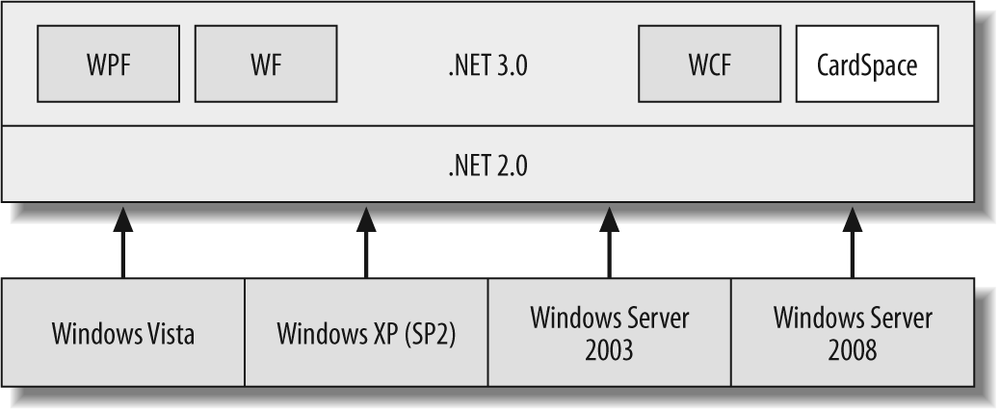Windows Communication Foundation (WCF), formerly code-named âIndigo,â is Microsoftâs platform for Service-Oriented Architecture (SOA), designed for building distributed service-oriented applications for the enterprise and the web. WCF was released with Windows Vista as part of the .NET Framework 3.0 (.NET 3.0) which includes four core technologies: Windows Presentation Foundation (WPF), Windows Workflow Foundation (WF), Windows Communication Foundation (WCF), and Windows CardSpace. As Figure 1-1 illustrates, .NET 3.0 relies on the .NET Framework 2.0 (.NET 2.0) and is supported on Windows XP, Windows Vista, Windows Server 2003, and Windows Server 2008 platforms.
Why release yet another technology for building distributed applications?? Unlike its predecessors, WCF is a truly service-oriented, loosely coupled, and interoperable platform. It simplifies service-oriented system design by removing the design dependencies that traditionally exist between how you access business functionality and the actual implementation of that business functionality. WCF promotes loose coupling not only between services and the functionality they expose, but also for choice of protocol, message encoding formats, and hosting environment. For example, services can be accessed over a variety of supported protocols, including named pipes, TCP, HTTP, and MSMQ. WCF also supports all of the core and emerging web service standards, which makes it a highly interoperable platform. Messages can always be represented in a format consistent with a set of well-adopted standards to communicate with other platforms.
Besides these modern characteristics, whatâs even more interesting is that you can now choose a single communication stack to gain access to the system services necessary to build a distributed system. WCF unifies the disparate programming paradigms you have previously used on the Windows platform to achieve similar goalsânamely .NET Remoting, ASP.NET Web Services (ASMX), and Enterprise Services. WCF provides all of the plumbing for security, transactions, and reliable messaging over any protocol. Only Enterprise Services came close to providing all of these features in a single stack, but your component design was coupled to the technology and limited to TCP communication (thus, not interoperable).
This chapter will be your introduction to the programming model of WCF. Iâll start by reviewing the principles of a Service Oriented Architecture and how WCF supports those principles. Iâll also describe some practical deployment scenarios for WCF in distributed enterprise systems and then summarize some of the fundamental WCF concepts that will be discussed first in this chapter and then elaborated on throughout this book. After introducing core WCF concepts, Iâll walk you through labs that exercise certain techniques and features. Instead of boring you with a bunch of âHello Worldâ examples, I plan to kick things up just a notch in this introductory chapter by enforcing good practices from the start while I teach you core concepts. Each of the labs you complete in this chapter will become successively more complex, and each will expose a new layer of detail. After each lab I will explain the relevant techniques and features you applied, discuss their relevance, and comment on recommended practices.
The labs in this chapter will cover the following topics:
Manually creating and consuming WCF services without the help of Visual Studio templates and related tools. This will provide you with a picture of the bare necessities you need to create, host, and consume a WCF service so that you understand the underlying programming model.
Creating WCF services using various Visual Studio project and service templates, leveraging configuration tools, and generating code to consume services.
Approaches to assembly allocation and service hosting over various protocols.
The importance of service metadata for publishing and consuming services.
By the end of this chapter you will be familiar with many core concepts including service contracts, endpoints, bindings, behaviors, hosting, metadata, channels, and proxies. Of course, throughout this book, the same concepts as well as additional ones will be discussed at length as you dive more deeply into specific WCF features.
Get Learning WCF now with the O’Reilly learning platform.
O’Reilly members experience books, live events, courses curated by job role, and more from O’Reilly and nearly 200 top publishers.


